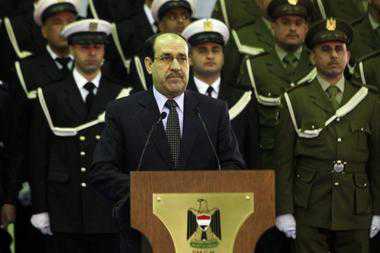Many analysts say the Middle East is the focus of a geopolitical power struggle between the United States and Iran. That misses the primary thread of events – namely, the ongoing soft partition of the Arab republics between Turkey and Iran, with Turkey the stronger power.
By Jason Pack and Martin van Creveld / January 6, 2012

Iraqi Prime Minister Nouri al- Maliki speaks to his supporters in Baghdad Dec. 31. The last two weeks’ events have removed any doubt that Mr. Maliki is “Iran’s man” in Baghdad.
AP Photo/Karim Kadim
Enlarge
During the last decade many right-wing American and Israeli analysts have described the geostrategic struggles unfolding in the Middle East as a new “cold war” pitting the United States against Shiite Iran. They have warned of an Arab “Shiite crescent” – stretching from Lebanon to Iraq – connected to Iran via ties of religion, commerce, and geostrategy.
Gallery: Monitor Political Cartoons
The new year has started with an attempted Shiite power play by Iraqi Prime Minister Nouri al-Maliki to dominate the government, and an Iranian demonstration of missile and nuclear fuel rod capacity coupled with threats to close the Straits of Hormuz if Iranian oil exports are blocked.
These events can be interpreted as ample evidence of Iranian expansionism, combined with fears that Iran will obtain a nuclear weapon, rendering its present regime and regional clients untouchable.
RELATED OPINION: Six ways to improve US relations in the new Middle East
What this view of the Middle East overlooks is the fact that both the US and Iran are mired in internal political and economic difficulties. Simultaneously, inside the region, both are being outmaneuvered by an ascendant Turkey.
via Turkey and Iran carve up a ruptured Arab world – CSMonitor.com.
more >>